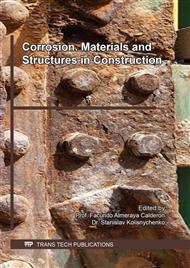p.73
p.79
p.84
p.91
p.97
p.103
p.109
p.115
p.123
Technology and Properties of Composite Materials with Modifier of Chloride Aluminum
Abstract:
The paper discusses the important issues concerning recycling of industrial sulfur waste and bottom ash. The process flow diagram was designed to form protective coatings on cement concrete by impregnation with molten sulfur, which featured high strength, performance properties and corrosion resistance. The process parameters were specified. The addition of bottom ash slag to cement concrete not only offers a means for recovering waste from thermal power stations, but also increases the material strength. Besides, the impregnation process provides low thermal conductivity for concrete while giving the material high heat insulation. A higher strength of the samples containing bottom ash slag results from a high dispersity and reactive surface of bottom ash slag. The paper investigates the influence of the electrophilic agent (aluminum chloride) on the properties of sulfur binder. It was shown that addition of aluminum chloride encouraged the formation of a more effective protective coating that gave the samples of cement concrete higher strength, density, water resistance. The electrophilic agent stimulated the synthesis process for inorganic sulfides and composite materials based on them. It was found that addition of the electrophilic agent (aluminum chloride) reduced the viscosity of molten sulfur significantly, which was attributed to the formed short-chain sulfur radicals. Such a melt has a relatively high penetration capability to ensure the formation of a high-quality protective coating.
Info:
Periodical:
Pages:
97-102
Citation:
Online since:
February 2019
Authors:
Price:
Сopyright:
© 2019 Trans Tech Publications Ltd. All Rights Reserved
Share:
Citation:



